ACCM4600 - Accounting Theory: Integrated Reporting Analysis
VerifiedAdded on 2022/08/18
|17
|3526
|9
Report
AI Summary
This report provides a comprehensive analysis of integrated reporting, beginning with its background and evolution from corporate reporting. It delves into the arguments for and against its adoption, highlighting advantages such as increased stakeholder understanding and value creation, while also addressing disadvantages like implementation costs and transparency concerns. The report further examines the skills required for successful implementation, including training programs and competency matrices, along with internal adoption strategies to maximize benefits. It explores the benefits at both management and reporting levels, emphasizing the importance of communication, risk reduction, and improved decision-making. The report concludes by emphasizing the importance of integrated reporting in enhancing business value and stakeholder relations.
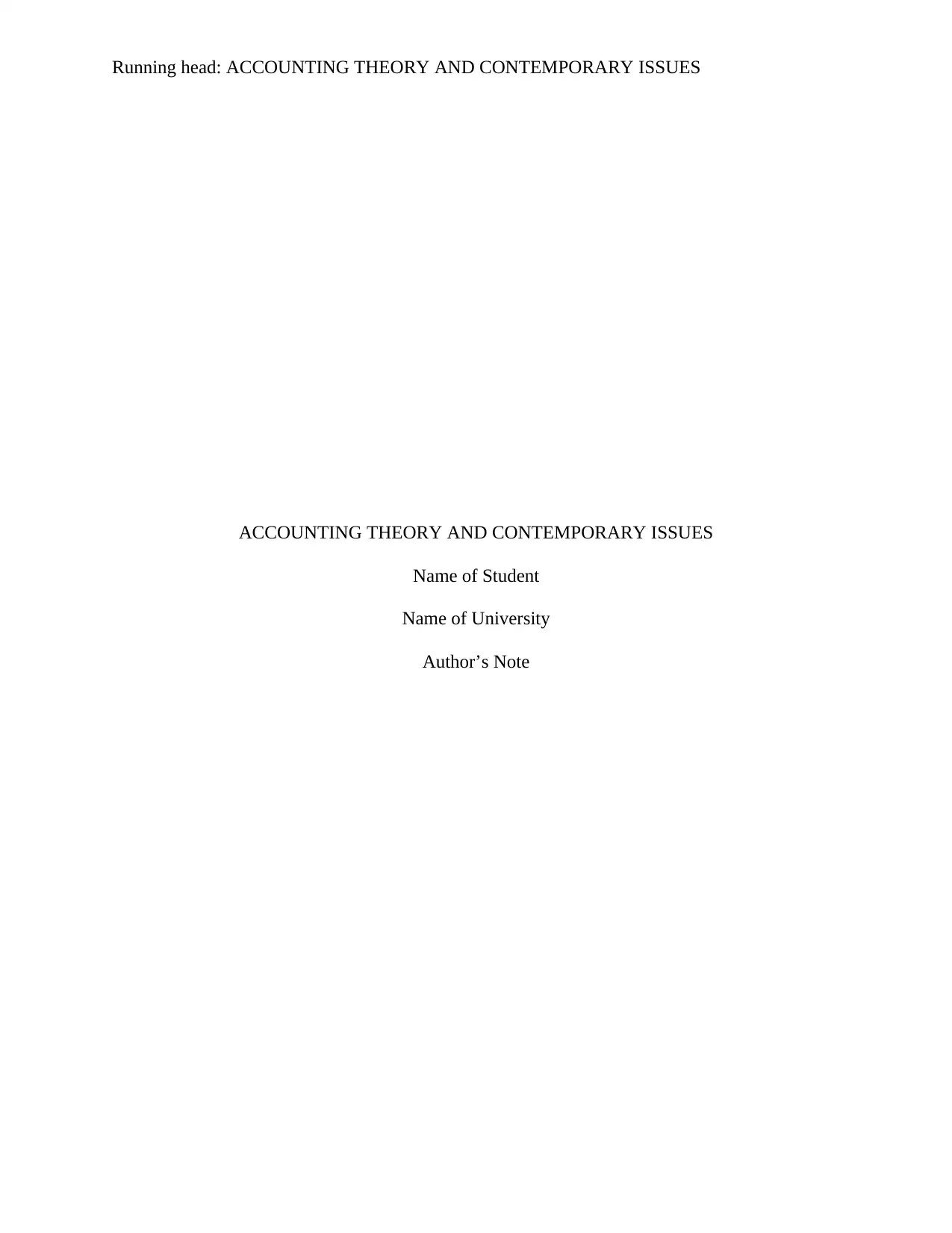
Running head: ACCOUNTING THEORY AND CONTEMPORARY ISSUES
ACCOUNTING THEORY AND CONTEMPORARY ISSUES
Name of Student
Name of University
Author’s Note
ACCOUNTING THEORY AND CONTEMPORARY ISSUES
Name of Student
Name of University
Author’s Note
Paraphrase This Document
Need a fresh take? Get an instant paraphrase of this document with our AI Paraphraser
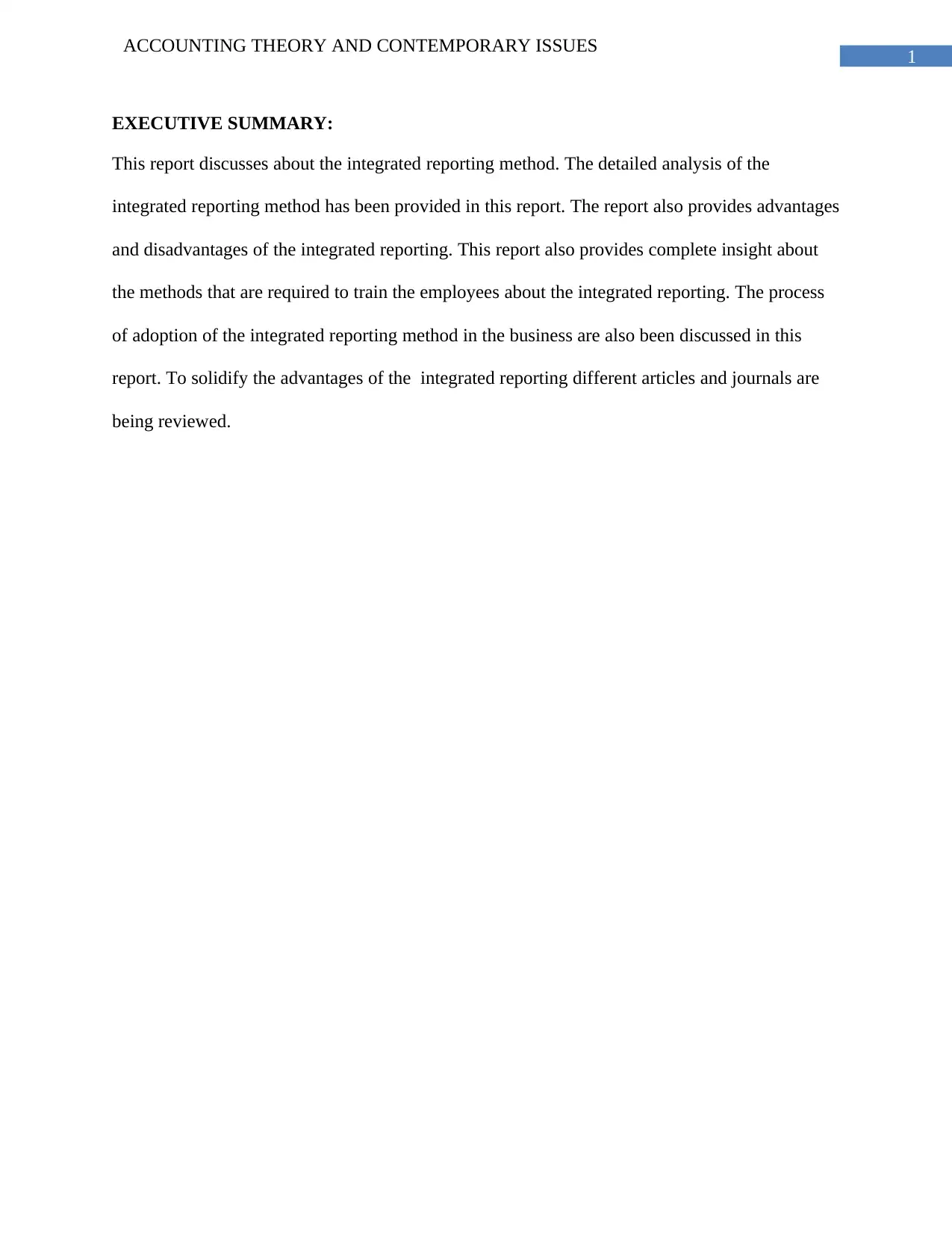
1
ACCOUNTING THEORY AND CONTEMPORARY ISSUES
EXECUTIVE SUMMARY:
This report discusses about the integrated reporting method. The detailed analysis of the
integrated reporting method has been provided in this report. The report also provides advantages
and disadvantages of the integrated reporting. This report also provides complete insight about
the methods that are required to train the employees about the integrated reporting. The process
of adoption of the integrated reporting method in the business are also been discussed in this
report. To solidify the advantages of the integrated reporting different articles and journals are
being reviewed.
ACCOUNTING THEORY AND CONTEMPORARY ISSUES
EXECUTIVE SUMMARY:
This report discusses about the integrated reporting method. The detailed analysis of the
integrated reporting method has been provided in this report. The report also provides advantages
and disadvantages of the integrated reporting. This report also provides complete insight about
the methods that are required to train the employees about the integrated reporting. The process
of adoption of the integrated reporting method in the business are also been discussed in this
report. To solidify the advantages of the integrated reporting different articles and journals are
being reviewed.

2
ACCOUNTING THEORY AND CONTEMPORARY ISSUES
ACCOUNTING THEORY AND CONTEMPORARY ISSUES
⊘ This is a preview!⊘
Do you want full access?
Subscribe today to unlock all pages.

Trusted by 1+ million students worldwide
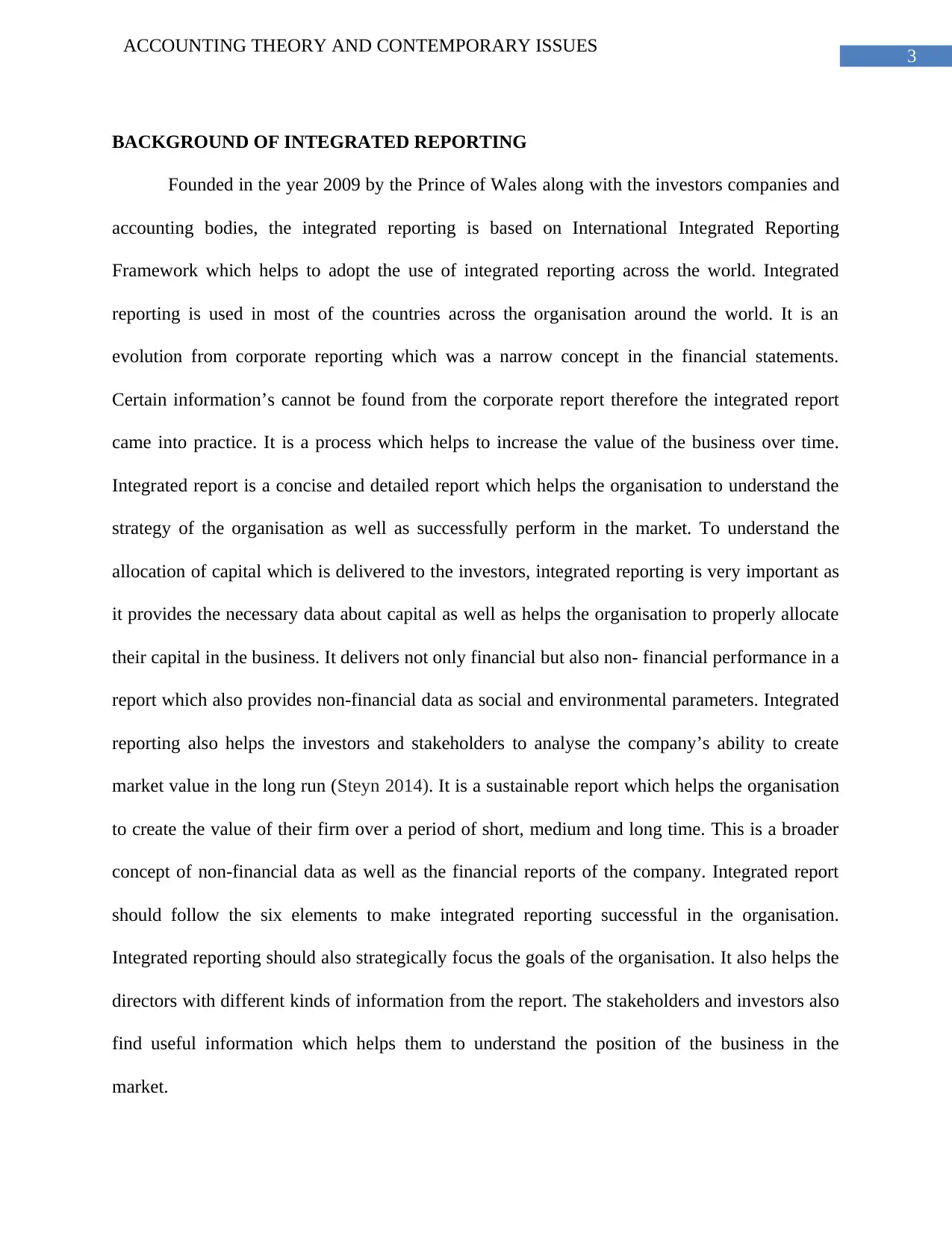
3
ACCOUNTING THEORY AND CONTEMPORARY ISSUES
BACKGROUND OF INTEGRATED REPORTING
Founded in the year 2009 by the Prince of Wales along with the investors companies and
accounting bodies, the integrated reporting is based on International Integrated Reporting
Framework which helps to adopt the use of integrated reporting across the world. Integrated
reporting is used in most of the countries across the organisation around the world. It is an
evolution from corporate reporting which was a narrow concept in the financial statements.
Certain information’s cannot be found from the corporate report therefore the integrated report
came into practice. It is a process which helps to increase the value of the business over time.
Integrated report is a concise and detailed report which helps the organisation to understand the
strategy of the organisation as well as successfully perform in the market. To understand the
allocation of capital which is delivered to the investors, integrated reporting is very important as
it provides the necessary data about capital as well as helps the organisation to properly allocate
their capital in the business. It delivers not only financial but also non- financial performance in a
report which also provides non-financial data as social and environmental parameters. Integrated
reporting also helps the investors and stakeholders to analyse the company’s ability to create
market value in the long run (Steyn 2014). It is a sustainable report which helps the organisation
to create the value of their firm over a period of short, medium and long time. This is a broader
concept of non-financial data as well as the financial reports of the company. Integrated report
should follow the six elements to make integrated reporting successful in the organisation.
Integrated reporting should also strategically focus the goals of the organisation. It also helps the
directors with different kinds of information from the report. The stakeholders and investors also
find useful information which helps them to understand the position of the business in the
market.
ACCOUNTING THEORY AND CONTEMPORARY ISSUES
BACKGROUND OF INTEGRATED REPORTING
Founded in the year 2009 by the Prince of Wales along with the investors companies and
accounting bodies, the integrated reporting is based on International Integrated Reporting
Framework which helps to adopt the use of integrated reporting across the world. Integrated
reporting is used in most of the countries across the organisation around the world. It is an
evolution from corporate reporting which was a narrow concept in the financial statements.
Certain information’s cannot be found from the corporate report therefore the integrated report
came into practice. It is a process which helps to increase the value of the business over time.
Integrated report is a concise and detailed report which helps the organisation to understand the
strategy of the organisation as well as successfully perform in the market. To understand the
allocation of capital which is delivered to the investors, integrated reporting is very important as
it provides the necessary data about capital as well as helps the organisation to properly allocate
their capital in the business. It delivers not only financial but also non- financial performance in a
report which also provides non-financial data as social and environmental parameters. Integrated
reporting also helps the investors and stakeholders to analyse the company’s ability to create
market value in the long run (Steyn 2014). It is a sustainable report which helps the organisation
to create the value of their firm over a period of short, medium and long time. This is a broader
concept of non-financial data as well as the financial reports of the company. Integrated report
should follow the six elements to make integrated reporting successful in the organisation.
Integrated reporting should also strategically focus the goals of the organisation. It also helps the
directors with different kinds of information from the report. The stakeholders and investors also
find useful information which helps them to understand the position of the business in the
market.
Paraphrase This Document
Need a fresh take? Get an instant paraphrase of this document with our AI Paraphraser
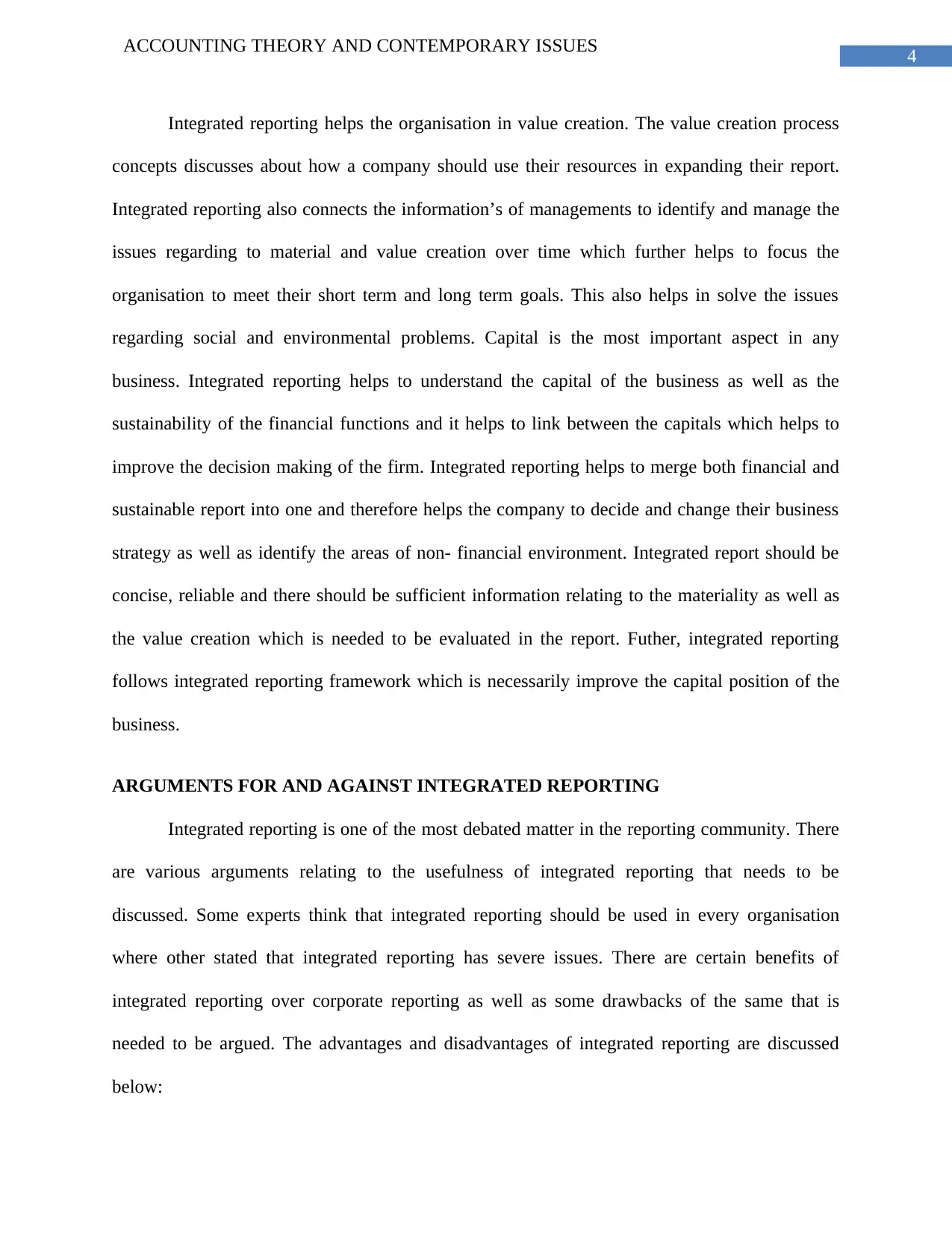
4
ACCOUNTING THEORY AND CONTEMPORARY ISSUES
Integrated reporting helps the organisation in value creation. The value creation process
concepts discusses about how a company should use their resources in expanding their report.
Integrated reporting also connects the information’s of managements to identify and manage the
issues regarding to material and value creation over time which further helps to focus the
organisation to meet their short term and long term goals. This also helps in solve the issues
regarding social and environmental problems. Capital is the most important aspect in any
business. Integrated reporting helps to understand the capital of the business as well as the
sustainability of the financial functions and it helps to link between the capitals which helps to
improve the decision making of the firm. Integrated reporting helps to merge both financial and
sustainable report into one and therefore helps the company to decide and change their business
strategy as well as identify the areas of non- financial environment. Integrated report should be
concise, reliable and there should be sufficient information relating to the materiality as well as
the value creation which is needed to be evaluated in the report. Futher, integrated reporting
follows integrated reporting framework which is necessarily improve the capital position of the
business.
ARGUMENTS FOR AND AGAINST INTEGRATED REPORTING
Integrated reporting is one of the most debated matter in the reporting community. There
are various arguments relating to the usefulness of integrated reporting that needs to be
discussed. Some experts think that integrated reporting should be used in every organisation
where other stated that integrated reporting has severe issues. There are certain benefits of
integrated reporting over corporate reporting as well as some drawbacks of the same that is
needed to be argued. The advantages and disadvantages of integrated reporting are discussed
below:
ACCOUNTING THEORY AND CONTEMPORARY ISSUES
Integrated reporting helps the organisation in value creation. The value creation process
concepts discusses about how a company should use their resources in expanding their report.
Integrated reporting also connects the information’s of managements to identify and manage the
issues regarding to material and value creation over time which further helps to focus the
organisation to meet their short term and long term goals. This also helps in solve the issues
regarding social and environmental problems. Capital is the most important aspect in any
business. Integrated reporting helps to understand the capital of the business as well as the
sustainability of the financial functions and it helps to link between the capitals which helps to
improve the decision making of the firm. Integrated reporting helps to merge both financial and
sustainable report into one and therefore helps the company to decide and change their business
strategy as well as identify the areas of non- financial environment. Integrated report should be
concise, reliable and there should be sufficient information relating to the materiality as well as
the value creation which is needed to be evaluated in the report. Futher, integrated reporting
follows integrated reporting framework which is necessarily improve the capital position of the
business.
ARGUMENTS FOR AND AGAINST INTEGRATED REPORTING
Integrated reporting is one of the most debated matter in the reporting community. There
are various arguments relating to the usefulness of integrated reporting that needs to be
discussed. Some experts think that integrated reporting should be used in every organisation
where other stated that integrated reporting has severe issues. There are certain benefits of
integrated reporting over corporate reporting as well as some drawbacks of the same that is
needed to be argued. The advantages and disadvantages of integrated reporting are discussed
below:
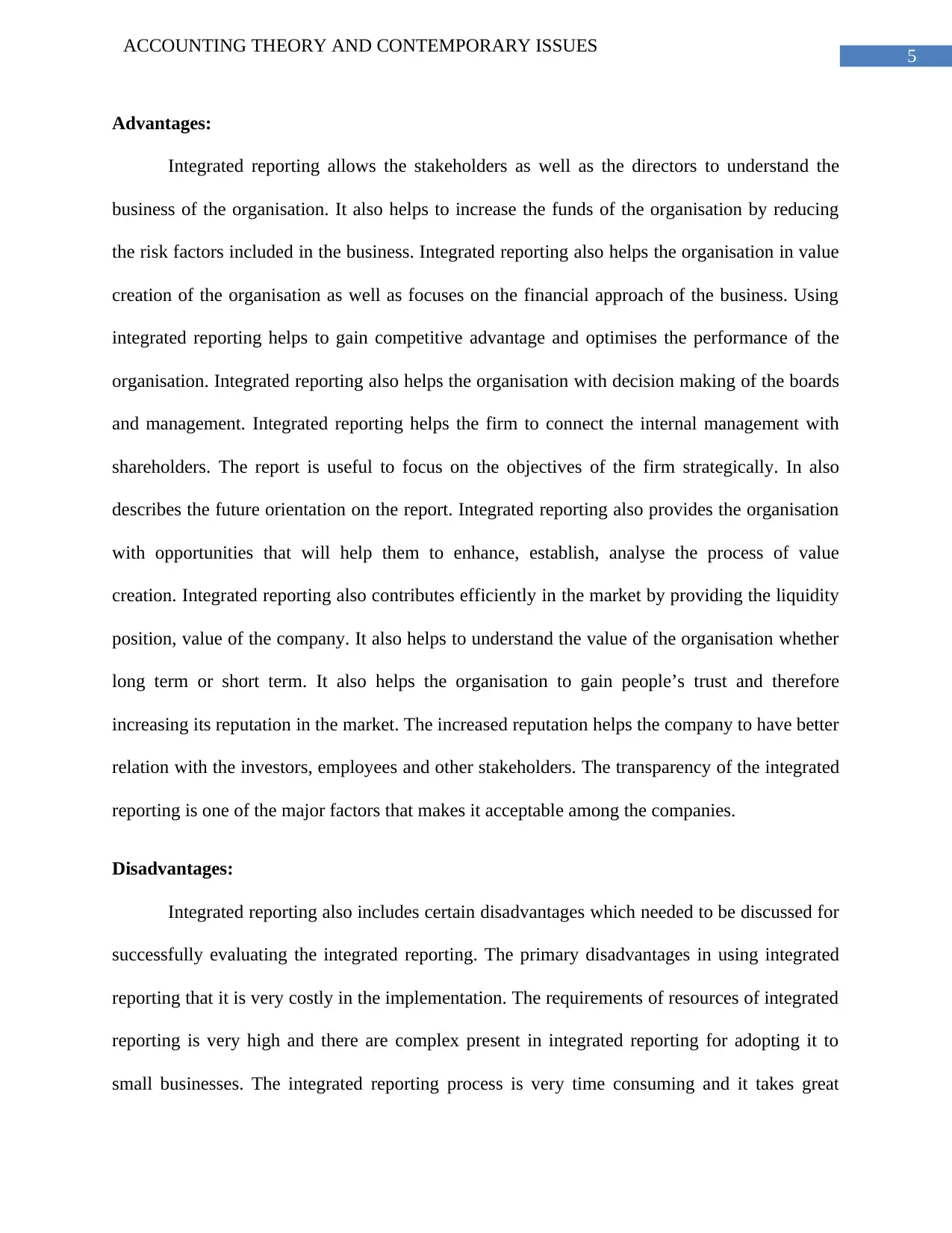
5
ACCOUNTING THEORY AND CONTEMPORARY ISSUES
Advantages:
Integrated reporting allows the stakeholders as well as the directors to understand the
business of the organisation. It also helps to increase the funds of the organisation by reducing
the risk factors included in the business. Integrated reporting also helps the organisation in value
creation of the organisation as well as focuses on the financial approach of the business. Using
integrated reporting helps to gain competitive advantage and optimises the performance of the
organisation. Integrated reporting also helps the organisation with decision making of the boards
and management. Integrated reporting helps the firm to connect the internal management with
shareholders. The report is useful to focus on the objectives of the firm strategically. In also
describes the future orientation on the report. Integrated reporting also provides the organisation
with opportunities that will help them to enhance, establish, analyse the process of value
creation. Integrated reporting also contributes efficiently in the market by providing the liquidity
position, value of the company. It also helps to understand the value of the organisation whether
long term or short term. It also helps the organisation to gain people’s trust and therefore
increasing its reputation in the market. The increased reputation helps the company to have better
relation with the investors, employees and other stakeholders. The transparency of the integrated
reporting is one of the major factors that makes it acceptable among the companies.
Disadvantages:
Integrated reporting also includes certain disadvantages which needed to be discussed for
successfully evaluating the integrated reporting. The primary disadvantages in using integrated
reporting that it is very costly in the implementation. The requirements of resources of integrated
reporting is very high and there are complex present in integrated reporting for adopting it to
small businesses. The integrated reporting process is very time consuming and it takes great
ACCOUNTING THEORY AND CONTEMPORARY ISSUES
Advantages:
Integrated reporting allows the stakeholders as well as the directors to understand the
business of the organisation. It also helps to increase the funds of the organisation by reducing
the risk factors included in the business. Integrated reporting also helps the organisation in value
creation of the organisation as well as focuses on the financial approach of the business. Using
integrated reporting helps to gain competitive advantage and optimises the performance of the
organisation. Integrated reporting also helps the organisation with decision making of the boards
and management. Integrated reporting helps the firm to connect the internal management with
shareholders. The report is useful to focus on the objectives of the firm strategically. In also
describes the future orientation on the report. Integrated reporting also provides the organisation
with opportunities that will help them to enhance, establish, analyse the process of value
creation. Integrated reporting also contributes efficiently in the market by providing the liquidity
position, value of the company. It also helps to understand the value of the organisation whether
long term or short term. It also helps the organisation to gain people’s trust and therefore
increasing its reputation in the market. The increased reputation helps the company to have better
relation with the investors, employees and other stakeholders. The transparency of the integrated
reporting is one of the major factors that makes it acceptable among the companies.
Disadvantages:
Integrated reporting also includes certain disadvantages which needed to be discussed for
successfully evaluating the integrated reporting. The primary disadvantages in using integrated
reporting that it is very costly in the implementation. The requirements of resources of integrated
reporting is very high and there are complex present in integrated reporting for adopting it to
small businesses. The integrated reporting process is very time consuming and it takes great
⊘ This is a preview!⊘
Do you want full access?
Subscribe today to unlock all pages.

Trusted by 1+ million students worldwide
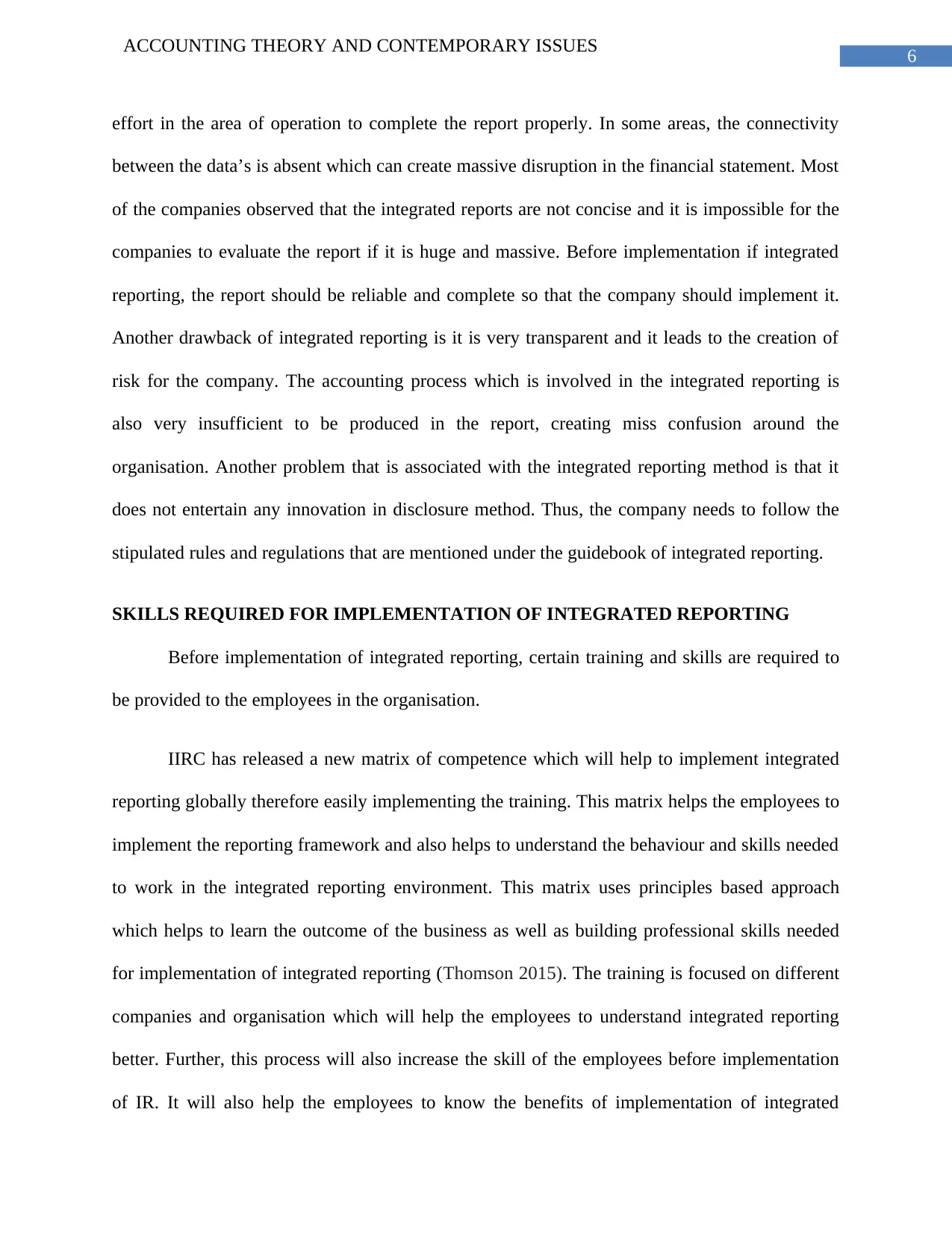
6
ACCOUNTING THEORY AND CONTEMPORARY ISSUES
effort in the area of operation to complete the report properly. In some areas, the connectivity
between the data’s is absent which can create massive disruption in the financial statement. Most
of the companies observed that the integrated reports are not concise and it is impossible for the
companies to evaluate the report if it is huge and massive. Before implementation if integrated
reporting, the report should be reliable and complete so that the company should implement it.
Another drawback of integrated reporting is it is very transparent and it leads to the creation of
risk for the company. The accounting process which is involved in the integrated reporting is
also very insufficient to be produced in the report, creating miss confusion around the
organisation. Another problem that is associated with the integrated reporting method is that it
does not entertain any innovation in disclosure method. Thus, the company needs to follow the
stipulated rules and regulations that are mentioned under the guidebook of integrated reporting.
SKILLS REQUIRED FOR IMPLEMENTATION OF INTEGRATED REPORTING
Before implementation of integrated reporting, certain training and skills are required to
be provided to the employees in the organisation.
IIRC has released a new matrix of competence which will help to implement integrated
reporting globally therefore easily implementing the training. This matrix helps the employees to
implement the reporting framework and also helps to understand the behaviour and skills needed
to work in the integrated reporting environment. This matrix uses principles based approach
which helps to learn the outcome of the business as well as building professional skills needed
for implementation of integrated reporting (Thomson 2015). The training is focused on different
companies and organisation which will help the employees to understand integrated reporting
better. Further, this process will also increase the skill of the employees before implementation
of IR. It will also help the employees to know the benefits of implementation of integrated
ACCOUNTING THEORY AND CONTEMPORARY ISSUES
effort in the area of operation to complete the report properly. In some areas, the connectivity
between the data’s is absent which can create massive disruption in the financial statement. Most
of the companies observed that the integrated reports are not concise and it is impossible for the
companies to evaluate the report if it is huge and massive. Before implementation if integrated
reporting, the report should be reliable and complete so that the company should implement it.
Another drawback of integrated reporting is it is very transparent and it leads to the creation of
risk for the company. The accounting process which is involved in the integrated reporting is
also very insufficient to be produced in the report, creating miss confusion around the
organisation. Another problem that is associated with the integrated reporting method is that it
does not entertain any innovation in disclosure method. Thus, the company needs to follow the
stipulated rules and regulations that are mentioned under the guidebook of integrated reporting.
SKILLS REQUIRED FOR IMPLEMENTATION OF INTEGRATED REPORTING
Before implementation of integrated reporting, certain training and skills are required to
be provided to the employees in the organisation.
IIRC has released a new matrix of competence which will help to implement integrated
reporting globally therefore easily implementing the training. This matrix helps the employees to
implement the reporting framework and also helps to understand the behaviour and skills needed
to work in the integrated reporting environment. This matrix uses principles based approach
which helps to learn the outcome of the business as well as building professional skills needed
for implementation of integrated reporting (Thomson 2015). The training is focused on different
companies and organisation which will help the employees to understand integrated reporting
better. Further, this process will also increase the skill of the employees before implementation
of IR. It will also help the employees to know the benefits of implementation of integrated
Paraphrase This Document
Need a fresh take? Get an instant paraphrase of this document with our AI Paraphraser
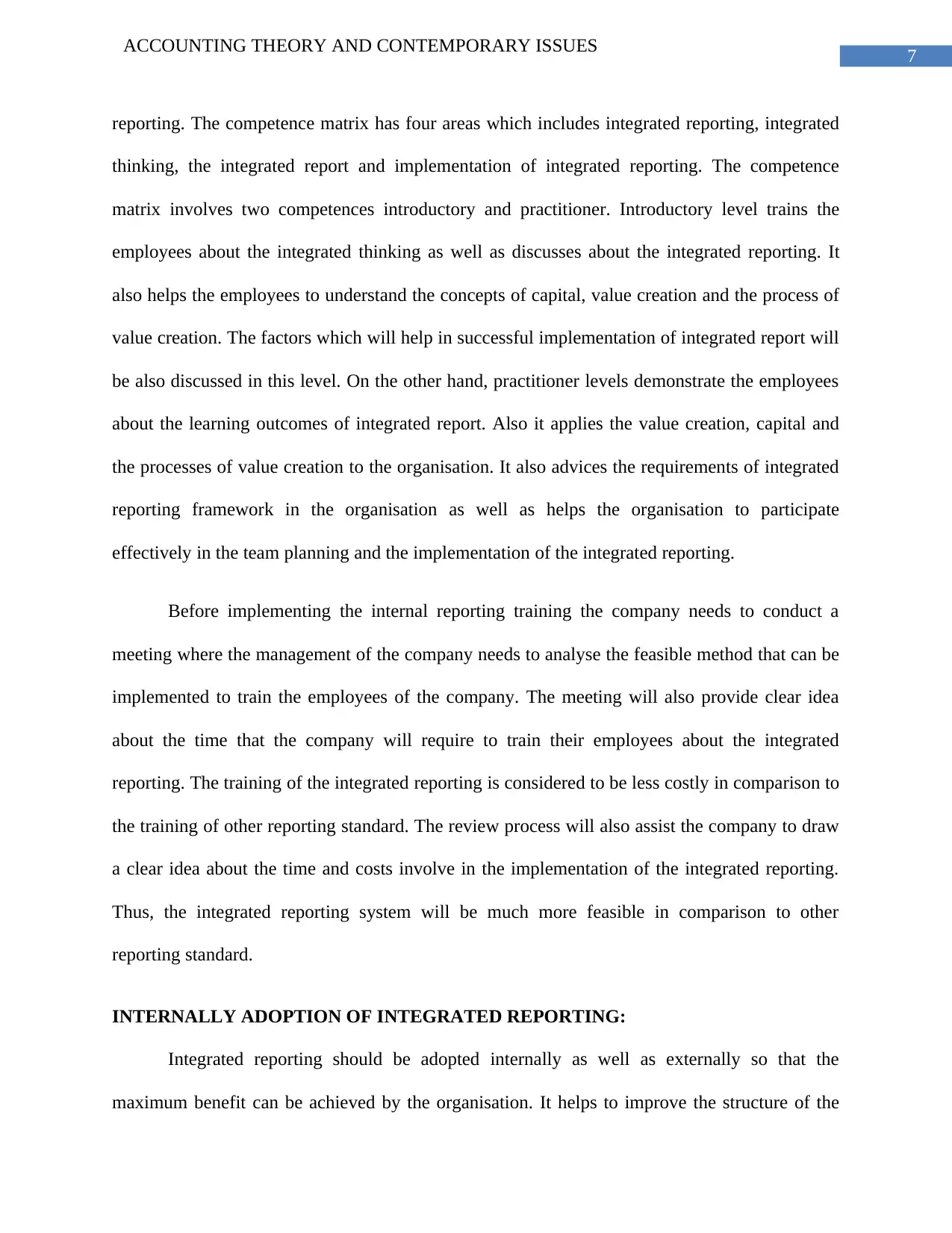
7
ACCOUNTING THEORY AND CONTEMPORARY ISSUES
reporting. The competence matrix has four areas which includes integrated reporting, integrated
thinking, the integrated report and implementation of integrated reporting. The competence
matrix involves two competences introductory and practitioner. Introductory level trains the
employees about the integrated thinking as well as discusses about the integrated reporting. It
also helps the employees to understand the concepts of capital, value creation and the process of
value creation. The factors which will help in successful implementation of integrated report will
be also discussed in this level. On the other hand, practitioner levels demonstrate the employees
about the learning outcomes of integrated report. Also it applies the value creation, capital and
the processes of value creation to the organisation. It also advices the requirements of integrated
reporting framework in the organisation as well as helps the organisation to participate
effectively in the team planning and the implementation of the integrated reporting.
Before implementing the internal reporting training the company needs to conduct a
meeting where the management of the company needs to analyse the feasible method that can be
implemented to train the employees of the company. The meeting will also provide clear idea
about the time that the company will require to train their employees about the integrated
reporting. The training of the integrated reporting is considered to be less costly in comparison to
the training of other reporting standard. The review process will also assist the company to draw
a clear idea about the time and costs involve in the implementation of the integrated reporting.
Thus, the integrated reporting system will be much more feasible in comparison to other
reporting standard.
INTERNALLY ADOPTION OF INTEGRATED REPORTING:
Integrated reporting should be adopted internally as well as externally so that the
maximum benefit can be achieved by the organisation. It helps to improve the structure of the
ACCOUNTING THEORY AND CONTEMPORARY ISSUES
reporting. The competence matrix has four areas which includes integrated reporting, integrated
thinking, the integrated report and implementation of integrated reporting. The competence
matrix involves two competences introductory and practitioner. Introductory level trains the
employees about the integrated thinking as well as discusses about the integrated reporting. It
also helps the employees to understand the concepts of capital, value creation and the process of
value creation. The factors which will help in successful implementation of integrated report will
be also discussed in this level. On the other hand, practitioner levels demonstrate the employees
about the learning outcomes of integrated report. Also it applies the value creation, capital and
the processes of value creation to the organisation. It also advices the requirements of integrated
reporting framework in the organisation as well as helps the organisation to participate
effectively in the team planning and the implementation of the integrated reporting.
Before implementing the internal reporting training the company needs to conduct a
meeting where the management of the company needs to analyse the feasible method that can be
implemented to train the employees of the company. The meeting will also provide clear idea
about the time that the company will require to train their employees about the integrated
reporting. The training of the integrated reporting is considered to be less costly in comparison to
the training of other reporting standard. The review process will also assist the company to draw
a clear idea about the time and costs involve in the implementation of the integrated reporting.
Thus, the integrated reporting system will be much more feasible in comparison to other
reporting standard.
INTERNALLY ADOPTION OF INTEGRATED REPORTING:
Integrated reporting should be adopted internally as well as externally so that the
maximum benefit can be achieved by the organisation. It helps to improve the structure of the
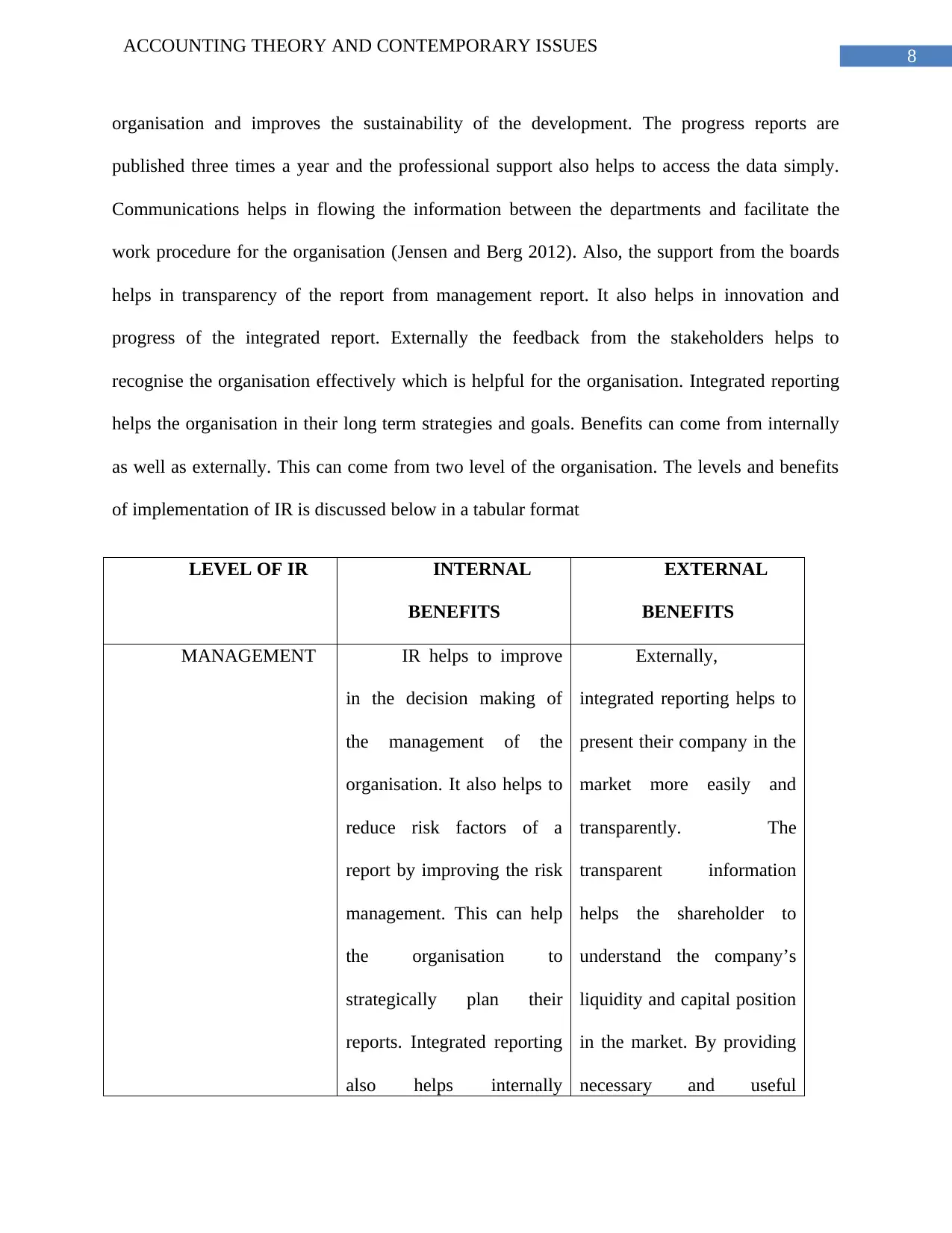
8
ACCOUNTING THEORY AND CONTEMPORARY ISSUES
organisation and improves the sustainability of the development. The progress reports are
published three times a year and the professional support also helps to access the data simply.
Communications helps in flowing the information between the departments and facilitate the
work procedure for the organisation (Jensen and Berg 2012). Also, the support from the boards
helps in transparency of the report from management report. It also helps in innovation and
progress of the integrated report. Externally the feedback from the stakeholders helps to
recognise the organisation effectively which is helpful for the organisation. Integrated reporting
helps the organisation in their long term strategies and goals. Benefits can come from internally
as well as externally. This can come from two level of the organisation. The levels and benefits
of implementation of IR is discussed below in a tabular format
LEVEL OF IR INTERNAL
BENEFITS
EXTERNAL
BENEFITS
MANAGEMENT IR helps to improve
in the decision making of
the management of the
organisation. It also helps to
reduce risk factors of a
report by improving the risk
management. This can help
the organisation to
strategically plan their
reports. Integrated reporting
also helps internally
Externally,
integrated reporting helps to
present their company in the
market more easily and
transparently. The
transparent information
helps the shareholder to
understand the company’s
liquidity and capital position
in the market. By providing
necessary and useful
ACCOUNTING THEORY AND CONTEMPORARY ISSUES
organisation and improves the sustainability of the development. The progress reports are
published three times a year and the professional support also helps to access the data simply.
Communications helps in flowing the information between the departments and facilitate the
work procedure for the organisation (Jensen and Berg 2012). Also, the support from the boards
helps in transparency of the report from management report. It also helps in innovation and
progress of the integrated report. Externally the feedback from the stakeholders helps to
recognise the organisation effectively which is helpful for the organisation. Integrated reporting
helps the organisation in their long term strategies and goals. Benefits can come from internally
as well as externally. This can come from two level of the organisation. The levels and benefits
of implementation of IR is discussed below in a tabular format
LEVEL OF IR INTERNAL
BENEFITS
EXTERNAL
BENEFITS
MANAGEMENT IR helps to improve
in the decision making of
the management of the
organisation. It also helps to
reduce risk factors of a
report by improving the risk
management. This can help
the organisation to
strategically plan their
reports. Integrated reporting
also helps internally
Externally,
integrated reporting helps to
present their company in the
market more easily and
transparently. The
transparent information
helps the shareholder to
understand the company’s
liquidity and capital position
in the market. By providing
necessary and useful
⊘ This is a preview!⊘
Do you want full access?
Subscribe today to unlock all pages.

Trusted by 1+ million students worldwide
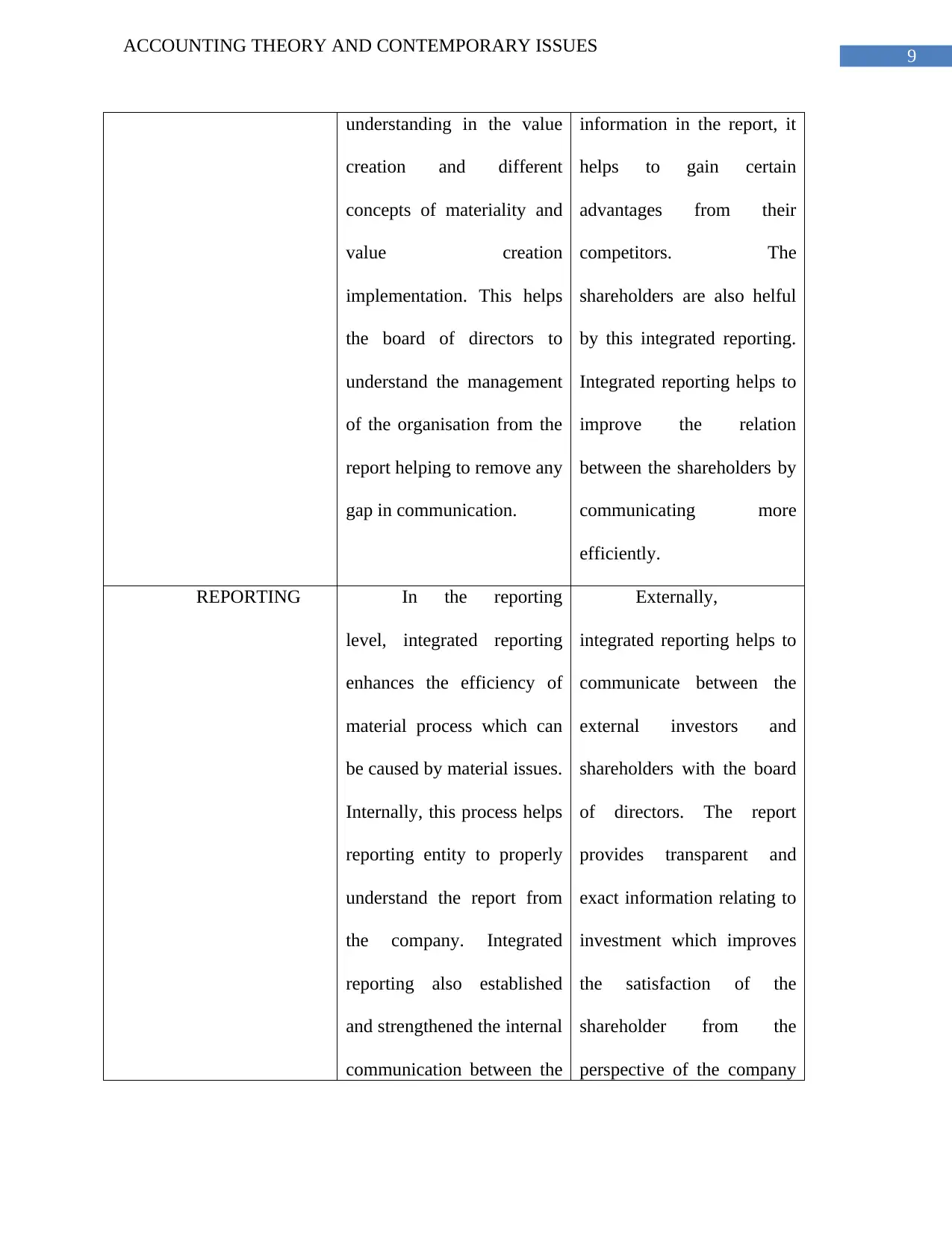
9
ACCOUNTING THEORY AND CONTEMPORARY ISSUES
understanding in the value
creation and different
concepts of materiality and
value creation
implementation. This helps
the board of directors to
understand the management
of the organisation from the
report helping to remove any
gap in communication.
information in the report, it
helps to gain certain
advantages from their
competitors. The
shareholders are also helful
by this integrated reporting.
Integrated reporting helps to
improve the relation
between the shareholders by
communicating more
efficiently.
REPORTING In the reporting
level, integrated reporting
enhances the efficiency of
material process which can
be caused by material issues.
Internally, this process helps
reporting entity to properly
understand the report from
the company. Integrated
reporting also established
and strengthened the internal
communication between the
Externally,
integrated reporting helps to
communicate between the
external investors and
shareholders with the board
of directors. The report
provides transparent and
exact information relating to
investment which improves
the satisfaction of the
shareholder from the
perspective of the company
ACCOUNTING THEORY AND CONTEMPORARY ISSUES
understanding in the value
creation and different
concepts of materiality and
value creation
implementation. This helps
the board of directors to
understand the management
of the organisation from the
report helping to remove any
gap in communication.
information in the report, it
helps to gain certain
advantages from their
competitors. The
shareholders are also helful
by this integrated reporting.
Integrated reporting helps to
improve the relation
between the shareholders by
communicating more
efficiently.
REPORTING In the reporting
level, integrated reporting
enhances the efficiency of
material process which can
be caused by material issues.
Internally, this process helps
reporting entity to properly
understand the report from
the company. Integrated
reporting also established
and strengthened the internal
communication between the
Externally,
integrated reporting helps to
communicate between the
external investors and
shareholders with the board
of directors. The report
provides transparent and
exact information relating to
investment which improves
the satisfaction of the
shareholder from the
perspective of the company
Paraphrase This Document
Need a fresh take? Get an instant paraphrase of this document with our AI Paraphraser
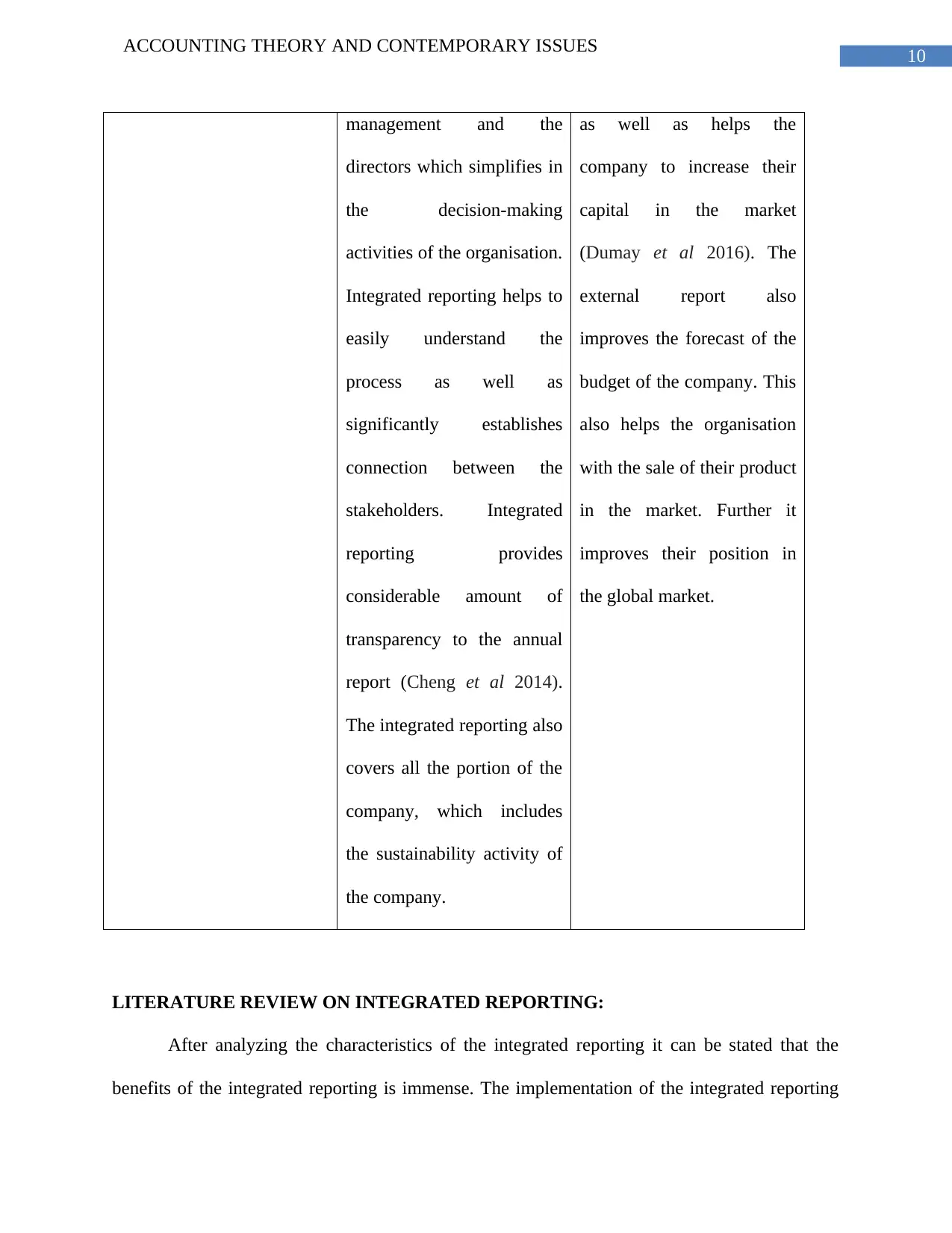
10
ACCOUNTING THEORY AND CONTEMPORARY ISSUES
management and the
directors which simplifies in
the decision-making
activities of the organisation.
Integrated reporting helps to
easily understand the
process as well as
significantly establishes
connection between the
stakeholders. Integrated
reporting provides
considerable amount of
transparency to the annual
report (Cheng et al 2014).
The integrated reporting also
covers all the portion of the
company, which includes
the sustainability activity of
the company.
as well as helps the
company to increase their
capital in the market
(Dumay et al 2016). The
external report also
improves the forecast of the
budget of the company. This
also helps the organisation
with the sale of their product
in the market. Further it
improves their position in
the global market.
LITERATURE REVIEW ON INTEGRATED REPORTING:
After analyzing the characteristics of the integrated reporting it can be stated that the
benefits of the integrated reporting is immense. The implementation of the integrated reporting
ACCOUNTING THEORY AND CONTEMPORARY ISSUES
management and the
directors which simplifies in
the decision-making
activities of the organisation.
Integrated reporting helps to
easily understand the
process as well as
significantly establishes
connection between the
stakeholders. Integrated
reporting provides
considerable amount of
transparency to the annual
report (Cheng et al 2014).
The integrated reporting also
covers all the portion of the
company, which includes
the sustainability activity of
the company.
as well as helps the
company to increase their
capital in the market
(Dumay et al 2016). The
external report also
improves the forecast of the
budget of the company. This
also helps the organisation
with the sale of their product
in the market. Further it
improves their position in
the global market.
LITERATURE REVIEW ON INTEGRATED REPORTING:
After analyzing the characteristics of the integrated reporting it can be stated that the
benefits of the integrated reporting is immense. The implementation of the integrated reporting
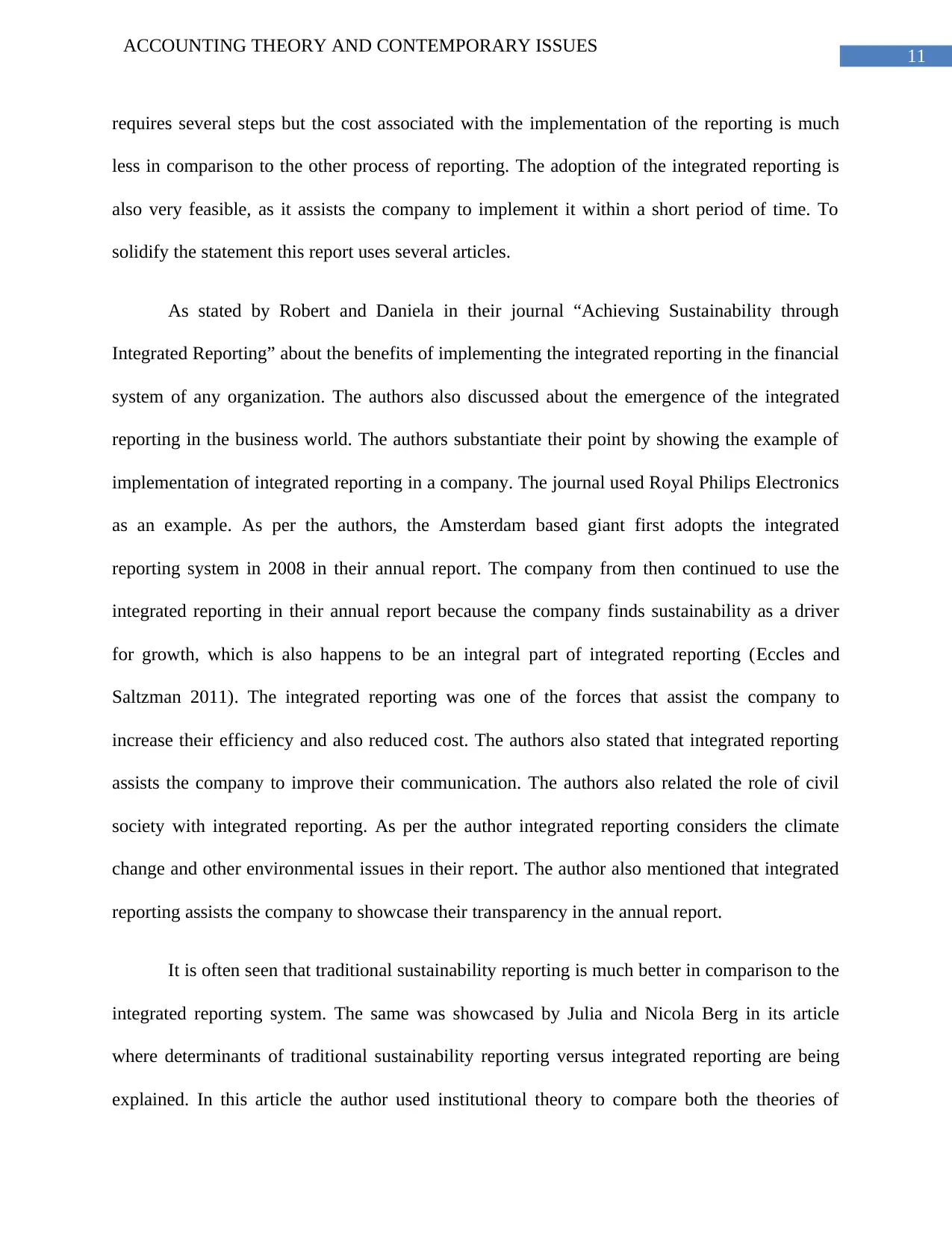
11
ACCOUNTING THEORY AND CONTEMPORARY ISSUES
requires several steps but the cost associated with the implementation of the reporting is much
less in comparison to the other process of reporting. The adoption of the integrated reporting is
also very feasible, as it assists the company to implement it within a short period of time. To
solidify the statement this report uses several articles.
As stated by Robert and Daniela in their journal “Achieving Sustainability through
Integrated Reporting” about the benefits of implementing the integrated reporting in the financial
system of any organization. The authors also discussed about the emergence of the integrated
reporting in the business world. The authors substantiate their point by showing the example of
implementation of integrated reporting in a company. The journal used Royal Philips Electronics
as an example. As per the authors, the Amsterdam based giant first adopts the integrated
reporting system in 2008 in their annual report. The company from then continued to use the
integrated reporting in their annual report because the company finds sustainability as a driver
for growth, which is also happens to be an integral part of integrated reporting (Eccles and
Saltzman 2011). The integrated reporting was one of the forces that assist the company to
increase their efficiency and also reduced cost. The authors also stated that integrated reporting
assists the company to improve their communication. The authors also related the role of civil
society with integrated reporting. As per the author integrated reporting considers the climate
change and other environmental issues in their report. The author also mentioned that integrated
reporting assists the company to showcase their transparency in the annual report.
It is often seen that traditional sustainability reporting is much better in comparison to the
integrated reporting system. The same was showcased by Julia and Nicola Berg in its article
where determinants of traditional sustainability reporting versus integrated reporting are being
explained. In this article the author used institutional theory to compare both the theories of
ACCOUNTING THEORY AND CONTEMPORARY ISSUES
requires several steps but the cost associated with the implementation of the reporting is much
less in comparison to the other process of reporting. The adoption of the integrated reporting is
also very feasible, as it assists the company to implement it within a short period of time. To
solidify the statement this report uses several articles.
As stated by Robert and Daniela in their journal “Achieving Sustainability through
Integrated Reporting” about the benefits of implementing the integrated reporting in the financial
system of any organization. The authors also discussed about the emergence of the integrated
reporting in the business world. The authors substantiate their point by showing the example of
implementation of integrated reporting in a company. The journal used Royal Philips Electronics
as an example. As per the authors, the Amsterdam based giant first adopts the integrated
reporting system in 2008 in their annual report. The company from then continued to use the
integrated reporting in their annual report because the company finds sustainability as a driver
for growth, which is also happens to be an integral part of integrated reporting (Eccles and
Saltzman 2011). The integrated reporting was one of the forces that assist the company to
increase their efficiency and also reduced cost. The authors also stated that integrated reporting
assists the company to improve their communication. The authors also related the role of civil
society with integrated reporting. As per the author integrated reporting considers the climate
change and other environmental issues in their report. The author also mentioned that integrated
reporting assists the company to showcase their transparency in the annual report.
It is often seen that traditional sustainability reporting is much better in comparison to the
integrated reporting system. The same was showcased by Julia and Nicola Berg in its article
where determinants of traditional sustainability reporting versus integrated reporting are being
explained. In this article the author used institutional theory to compare both the theories of
⊘ This is a preview!⊘
Do you want full access?
Subscribe today to unlock all pages.

Trusted by 1+ million students worldwide
1 out of 17
Related Documents
Your All-in-One AI-Powered Toolkit for Academic Success.
+13062052269
info@desklib.com
Available 24*7 on WhatsApp / Email
![[object Object]](/_next/static/media/star-bottom.7253800d.svg)
Unlock your academic potential
Copyright © 2020–2025 A2Z Services. All Rights Reserved. Developed and managed by ZUCOL.




